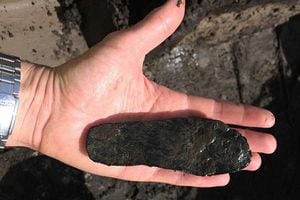Archaeologists unearth Roman remains in Whitchurch
Archaeologists have unearthed remains which provide important new evidence of Roman life in Whitchurch.

Pottery and leather children's shoes are among the items found on a site just to the south of London Road.
The remains were discovered by archaeologists from the Environment Agency, Shropshire Council's historic environment team and Salford University.
The remains were found during work by the Environment Agency to replace a partially collapsed culvert carrying the Staggs Brook in Whitchurch.
The site lies on the edge of the historic town centre and just beyond the likely edge of the Roman settlement.
Before the project began it was identified that the line of the culvert to the south of London Road had some potential to contain historic remains. As a result, archaeologists from the Centre for Applied Archaeology at Salford University were on hand when work for the new culvert began.
However, the archaeologists were surprised to discover an unexpectedly rich series of waterlogged deposits that included the remains of a wooden trackway, a number of structural timbers, a large amount of Roman pottery and, most importantly of all, fifteen leather shoes.
Both adult and children's shoes were present, a number of which were complete and included impressed decoration.
The finds that were recovered during the construction of the new culvert were preserved by the wet silts along the side of the brook.
Work remains ongoing but archaeologists think that the trackway lay immediately beyond the edge of the Roman town and crossed the wet valley bottom. The other finds appear to result from the dumping of rubbish along the edge of an open stream.
Andy Wigley, natural and historic environment manager at Shropshire Council, said: "My team was pleased to be able to assist the Environment Agency, their engineering consultants Keir, and the archaeologists from Salford University with this project.
"The finds from this site are hugely important for Shropshire and will give us invaluable new insights into everyday life in Roman Whitchurch."
Ian Gemmell, project manager from the Environment Agency, said: "It was a great surprise to discover these significant finds during our excavation work to replace the damaged culvert.
"While we knew it was possible that some Roman artefacts could be present, we did not expect to find items of such importance.
"We are delighted by the opportunity this now affords the local community to study and learn what the Romans and townsfolk were doing alongside this now buried watercourse."





